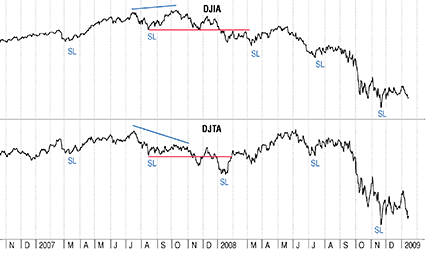cycles
Where Are We Headed?
Dow Theory Direction
Why do opinions on Dow theory so often vary, and why do Dow theory “signals” so often fail?
Typically, there is one common denominator that becomes immediately apparent in most articles about Dow theory: too many of the authors of those articles have not studied the original writings of Charles H. Dow, William Peter Hamilton, or Robert Rhea. These original writings and particularly those of Robert Rhea are essential if we are to understand what has come to be known as Dow theory. The only other person I know who has studied the original writings by Dow, Hamilton, and Rhea is Richard Russell. As a result, Russell is the only other orthodox Dow theorist I know of, and he has fought misquotes, misunderstandings, and erroneously written articles about Dow theory his entire career.
Nonconfirmation and the ongoing bear
I first warned about the Dow theory nonconfirmation, and the impending bear market, in October 2007. There was approximately a four-week period following the October 9, 2007, closing high on the Dow Jones industrials that was a classic “sell spot” in accordance with orthodox Dow theory. It was during this time that I began warning my subscribers and guided them through the developments as we watched the primary bearish trend take root.
According to orthodox Dow theory, the primary bearish trend change finally occurred on November 21, 2007. It was then that the stock market barometer first forecasted “stormy economic conditions,” according to Hamilton.
Many market observers misunderstand Dow theory, viewing the violation of the previous lows or the bettering of previous highs to be a buy or sell signal in accordance with the theory. This is not true. In the writings of the founding fathers of Dow theory, the violation of joint secondary highs or lows is clearly considered to be confirmation of a primary trend change in which they would have already established positions at what they refer to as “buy and sell spots.” So the first myth I want to bust here is that Dow theory buy and sell signals do not come once a joint secondary high or low is exceeded. In reality, the violation of these levels serves as confirmation of the primary trend.

FIGURE 1: dow theory. The most important aspect of Dow theory is the joint movement of the industrials and the transports above and below secondary high and low points. Learning to identify what constitutes a secondary high and low point takes experience, which can be learned from the writings of the Dow theory founding fathers.
As the averages rallied out of the January—March secondary low points, and into the May—June 2008 and even the August 2008 highs, I continuously explained that nothing had occurred to invalidate the establishment of the November 21, 2007, primary bearish trend confirmation. Yet some who do not truly understand Dow theory misinterpret the movement above the February highs as bullish. The most important aspect of Dow theory is the joint movement of the industrials and the transports above and below previous secondary high and low points.